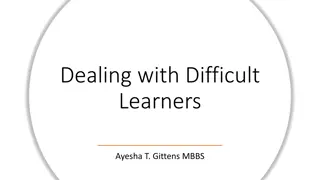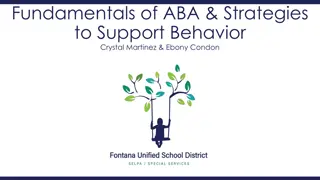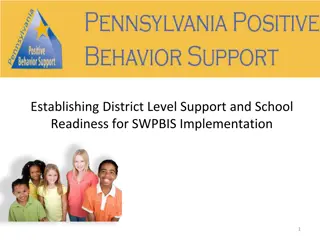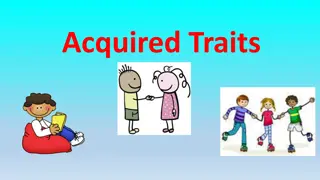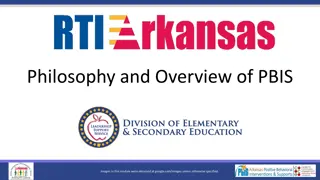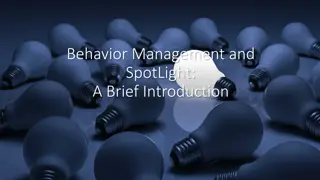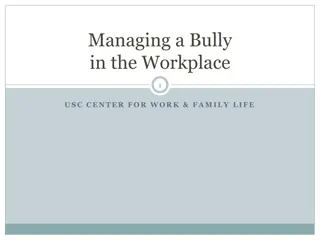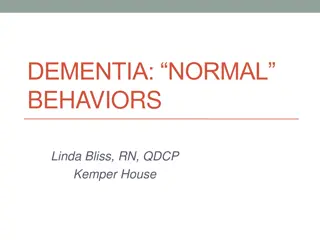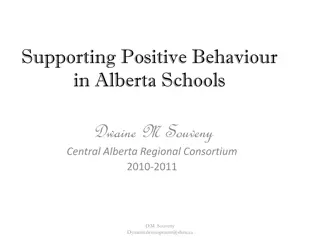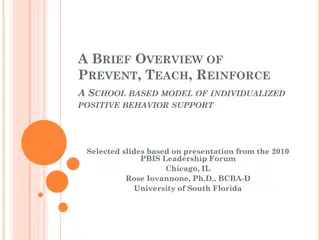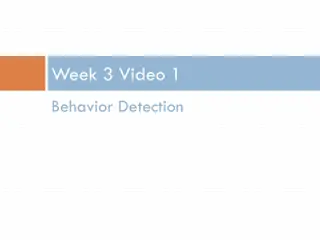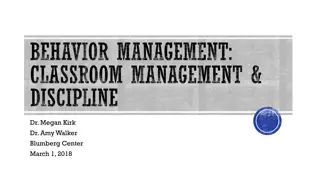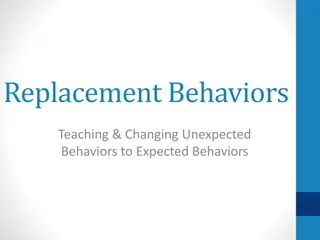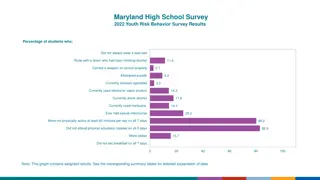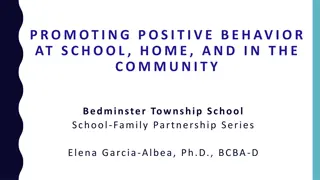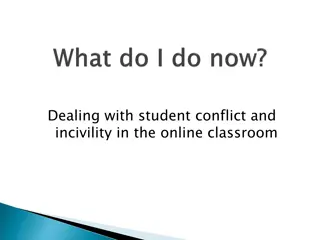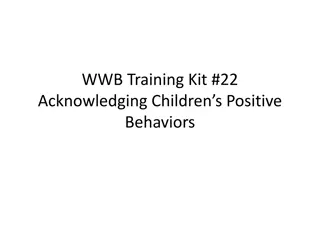Positive Behavior Support in School: Dealing with Challenging Behaviors
Understanding and addressing challenging behaviors in school is crucial for creating a respectful and inclusive environment. This involves using appropriate management strategies, agreed consequences, and clear communication with staff, students, and parents. By teaching social behavior and ensuring consistency in handling inappropriate actions, schools can help all students thrive.
Download Presentation

Please find below an Image/Link to download the presentation.
The content on the website is provided AS IS for your information and personal use only. It may not be sold, licensed, or shared on other websites without obtaining consent from the author.If you encounter any issues during the download, it is possible that the publisher has removed the file from their server.
You are allowed to download the files provided on this website for personal or commercial use, subject to the condition that they are used lawfully. All files are the property of their respective owners.
The content on the website is provided AS IS for your information and personal use only. It may not be sold, licensed, or shared on other websites without obtaining consent from the author.
E N D
Presentation Transcript
Twilight 21stNovember 2019
Behind the (challenging) Behaviour Positive Behaviour Support What behaviours do you find challenging? Discuss with the people on your table.
At School XXXXX, we believe good behaviour is based on mutual respect. This starts from the moment the child enters school in the way that adults interact with the children, children interact with adults and the way children interact with each other. Being Inclusive Some individuals need more support than others in learning to respect the rights of others and to meet the school s expectations of behaviour. We have a responsibility to teach social behaviour to all children. We should be clear with staff, pupils, parents/carers, governors about which expectations are non-negotiable. All pupils have the right to be educated no matter how challenging their behaviour. Dealing with challenging behaviour often helps us to find ways to improve our systems, processes and procedures. We should seek to adapt these to fit our diverse populations.
Dealing with inappropriate behaviour Dealing with inappropriate behaviour Elmwood has agreed consequences for different stages of behaviour, which are followed consistently. Each child should be given a fresh start as soon as possible. A child should be given time to reflect and then apologise for poor behaviour choices. At no point do we issue blanket sanctions for a class.
Step 1 Step 1 Talking to peers when an adult is talking, calling out answers instead of raising a hand, making silly comments to get attention, minor squabbles with peers. Most behavioural issues in the classroom and around the school are to be dealt with by the class teacher or the first adult who observes the behaviour or is informed of the incident. In the first instance staff are expected to use appropriate behaviour management strategies to deal with behaviour problems in their own class. The next steps should not be taken unless and until the child / children have been: Spoken to about their behaviour by their class teacher / member of staff Moved within the classroom Supported in their learning Warned about the consequences of their behaviour
Step 2 Step 2 Actions that stop others from learning, rude language, aggressive behaviour, damage to school property, refusal to follow an instruction) If, following the class teacher s own behaviour strategies, the child s behaviour is deemed to be affecting their own and other children s learning, they can be sent to a class within the year group for 10 minutes with their work. A sand timer should be used during this time to avoid children being removed from their classroom for long periods of time. If a child is sent from the classroom more than twice a week or if there is a serious incident, the class teacher should inform the child s parents / carers. A note should be recorded in the behaviour book that the discussion has taken place. Each class has a behaviour book to record incidents of inappropriate / incidents of behaviour. This will include if a child is sent out of class more than twice and a record of any conversations held with the parents / carers.
Step 3 Step 3 Inappropriate language, repeated misbehaviour for attention in class, aggressive behaviour towards others, biting, persistent disruption, racist comments / incident. A child may have privileges withdrawn, for example losing playtime or lunchtime play. The member of staff issuing the sanction must supervise the child / children and where serious incidents occur a Year Group Leader or member of SLT may supervise the children during this time. Where a child s behaviour is causing concern, a meeting will be arranged with the class teacher and the child s parents / carers, to review strategies to promote positive behaviours. Strategies will be agreed, implemented and monitored. If there are persistent ongoing concerns, a subsequent meeting will be called which will include a member of the Senior Leadership Team. Recognition of pupils difficulties will be supported by a Behaviour Support Plan, which will be drawn up in consultation with parents / carers and the pupil concerned. In the interest of fairness, the pupil will have opportunity to express his/her view or version of events. Racial comments / incident must always be reported to a member of the SLT.
Step 4 Dangerous and extreme behaviour may, if all other avenues have been exhausted, result in the child being given an in-house exclusion from class or formal fixed term exclusion. The school follows the guidelines set by the Department of Education for formal fixed term exclusions. In the event of a serious incident that may affect the safety of other children, a member of the Senior Leadership Team must be immediately informed and they will attend immediately.
Think of a behaviour incident you have dealt with recently. Keep this in mind throughout the session.
Inspecting safeguarding in early years, education and skills (from September 2019) 'Adults understand that children s poor behaviour may be a sign that they are suffering harm or that they have been traumatised by abuse'
Factors Influencing Human Behaviour In small groups,make a list of the factors that influence human behaviour. Why would one person behave differently to another in the same circumstance? Research suggests that challenging behaviour occurs when a person has little control over their life and tries to exercise some, or because a person is distressed at his or her ability to make others understand what he or she needs. (Ashman, Ockenden, Mansell, Beadle-Brown 2010).
Social Media Food Drug & Alcohol Misuse Bereave- ment Shelter SEND CSE Health Young Carer Trauma Medical Needs Expect- ations Safe- guarding Crime Poverty Finances Gangs DASV Sleep Siblings Loss
It is also a widely accepted fact that challenging behaviour is influenced by the person s quality of life. Generally speaking, the better a person s quality of life, the less likely they are to present challenging behaviours.
Picture the scene. The child continues to distract others during the independent work as it is not the task you actually planned for her to do. You become frustrated and end up shouting at the child. The child then throws her work on the floor, pushes the chair over and kicks you. One of the children in your class comes in to school a little tearful but you were busy making amendments to the lesson so didn t catch the parent to find out why. She distracts others during the teaching input and you snap at her. You arrive at work a little late as the traffic was bad and someone catches you in the corridor to ask you to swap playground duty. Then the photocopier stops working so you don t have all the resources you need. You have a disagreement over finances with a family member and don t sleep well. You over- sleep and have to rush to get to work on time, skipping breakfast.
Being able to recognise a chids CUES helps us to begin to de-escalate the situation. Physical changes might include an increased heart rate, heavier/faster breathing, restless ness, sweating, tremors. Psychological changes might include loss of ability to think rationally, heightened focus on the trigger, a loss of emotional control. When a person escalates from their baseline to loss of control, they are effected physically and psychologically.
How long does it take, on average, to return from crisis point/10 back to baseline? Anything from 45 minutes upwards Depending on the individual and the circumstances.
Wheres your baseline? What are your triggers/setting events? If a child has an argument at playtime, will they be on baseline for their learning after break? What if they come in from home upset about something? The baseline is the only place where a child will be able to learn
It is a form of communication It gets a TANGIBLE REWARD It has a SENSORY function Challenging behaviour achieves something.. It AVOIDS something or helps the child escape from a situation It gets your ATTENTION Behind every behaviour there will be an unmet need. It makes you go away
Strategies Teach the child/adult a coping skill or strategy. Reduce exposure to the trigger Remove the trigger
The behaviour of human beings is directly influenced by the behaviour or those around them How we behave when faced with someone who is angry or upset can directly affect the outcome. If we are calm and controlled in our approach, it is much more likely that there will be a positive outcome (de-escalation) as compared with being aggressive, confrontational or over-bearing which may only serve to escalate the situation.
Managing Behaviour - S T E P S SPACE Aim: To respect personal space and promote safety Action: Stand at 2 arms-length from the person TOUCH Aim: To not provoke a negative reaction from the person Action: DO NOT TOUCH EYE CONTACT Aim: To not provoke a negative reaction from the person Action: Do not stare. Avoid sustained eye contact but do look at the person as they need to know our focus is on them. POSTURE Aim: To not provoke a negative reaction from the person. Action: Face the person, lowered shoulders, arm down, hands open (appear relaxed and confident. SPEECH Aim : To positively engage the person and not provoke a negative reaction Action: Do NOT shout. Be aware of your tone and volume.
What to say and how to say it If you were upset, angry or distressed, which approach would you rather have? Not helpful Stop that! Don t ..! Why ? You're being stupid! You re letting yourself down! Behave yourself! Stop making a fuss! Helpful I can see you are upset. How can I help? What s wrong? It will be ok. Would you like to Let s go I understand. Please Use your words ..
Diversion and Distraction Using diversion or distraction is a powerful way of de-escalating a situation. We need to find something that will grab the person s attention when they are angry, frustrated or upset. Knowing the person and their likes/dislikes is the key to developing the right strategy.
Physical Contact when is it ok? Physical contact, or touch is often a necessary part of providing care and support. For example, high fives, support with handwriting, hand shakes, side on hugs, help with dressing, intimate care (where appropriate and necessary), hand-holding to give support, assisting a child to get up from the floor. Children should never sit on your lap unless there is an exceptional circumstance. It may be appropriate to use light touch to guide someone when escorting them if they are unsteady on their feet. For example, when a child needs first aid.
Restrictive Practice The implementation of any practice or practices that restrict an individual s movement, liberty and/or freedom to act independently without coercion or consequence. Preventing a child from getting past/exiting a room. Holding a child s wrist and guiding them to a place in the line. Lifting a child from the floor. Taking a child s hand and taking them to another room. Putting a hand in the small of a child s back and guiding them somewhere. Carrying a child Is there sufficient justification? Is it on their behaviour/SEND support plan?
Think of a behaviour incident you have dealt with recently. Keep this in mind throughout the session. Would you do anything differently?
What have you learnt? ? Will you do anything differently? ?




